Literature Review on Personal Costs of Citizenship Behavior and Counterproductive Work Behaviors
VerifiedAdded on 2023/06/07
|12
|3322
|368
AI Summary
This literature review discusses two articles on the personal costs of citizenship behavior and counterproductive work behaviors. The first article examines the relationship between individual initiative, role overload, job stress, and work-family conflict. The second article determines whether counterproductive work behaviors can contribute to benefit the employees. Both articles cover topics such as job stress, work overload, emotional exhaustion, work-family imbalance, and organizational justice. The articles are relevant for the subject of organizational behavior and can be helpful for students pursuing courses related to human resource management, organizational behavior, and psychology.
Contribute Materials
Your contribution can guide someone’s learning journey. Share your
documents today.
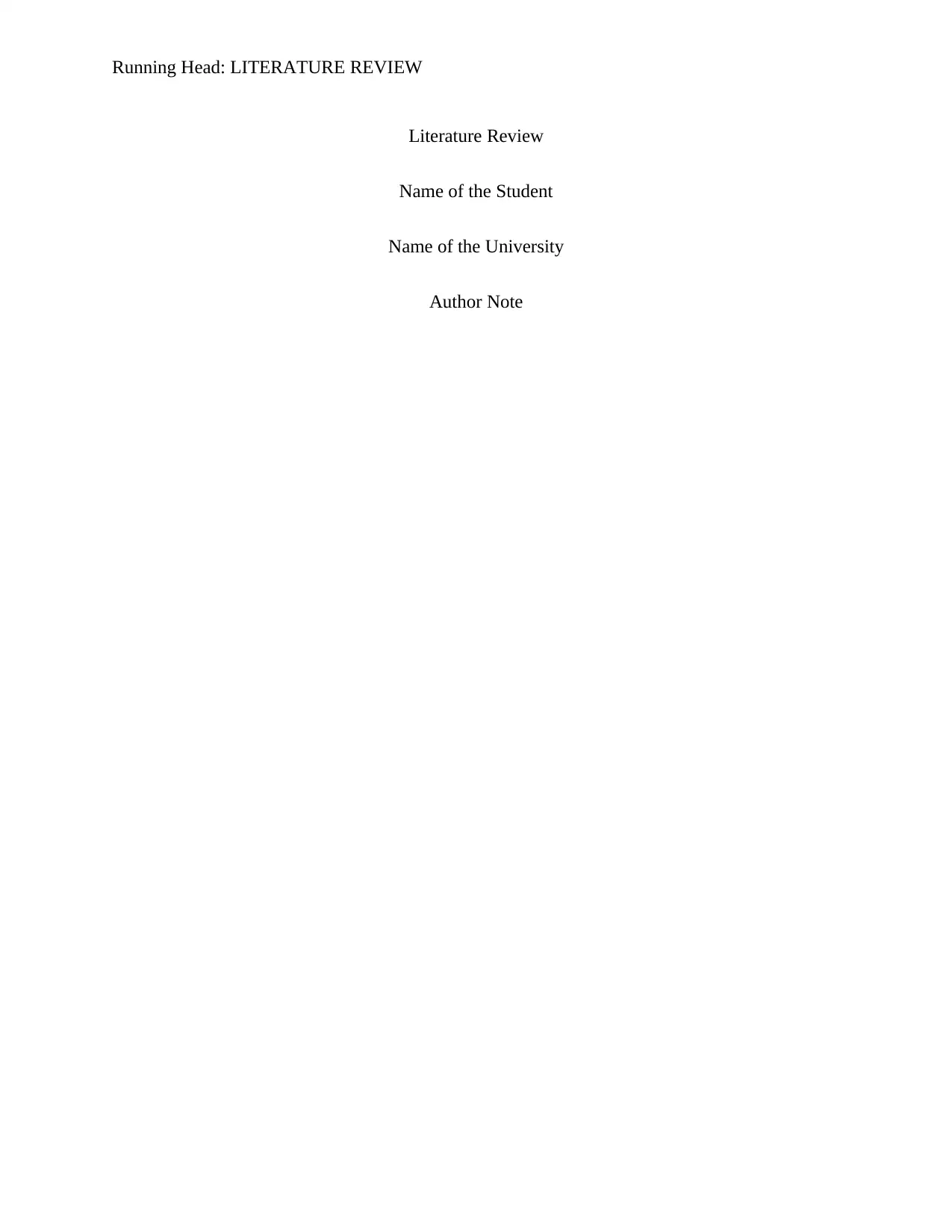
Running Head: LITERATURE REVIEW
Literature Review
Name of the Student
Name of the University
Author Note
Literature Review
Name of the Student
Name of the University
Author Note
Secure Best Marks with AI Grader
Need help grading? Try our AI Grader for instant feedback on your assignments.
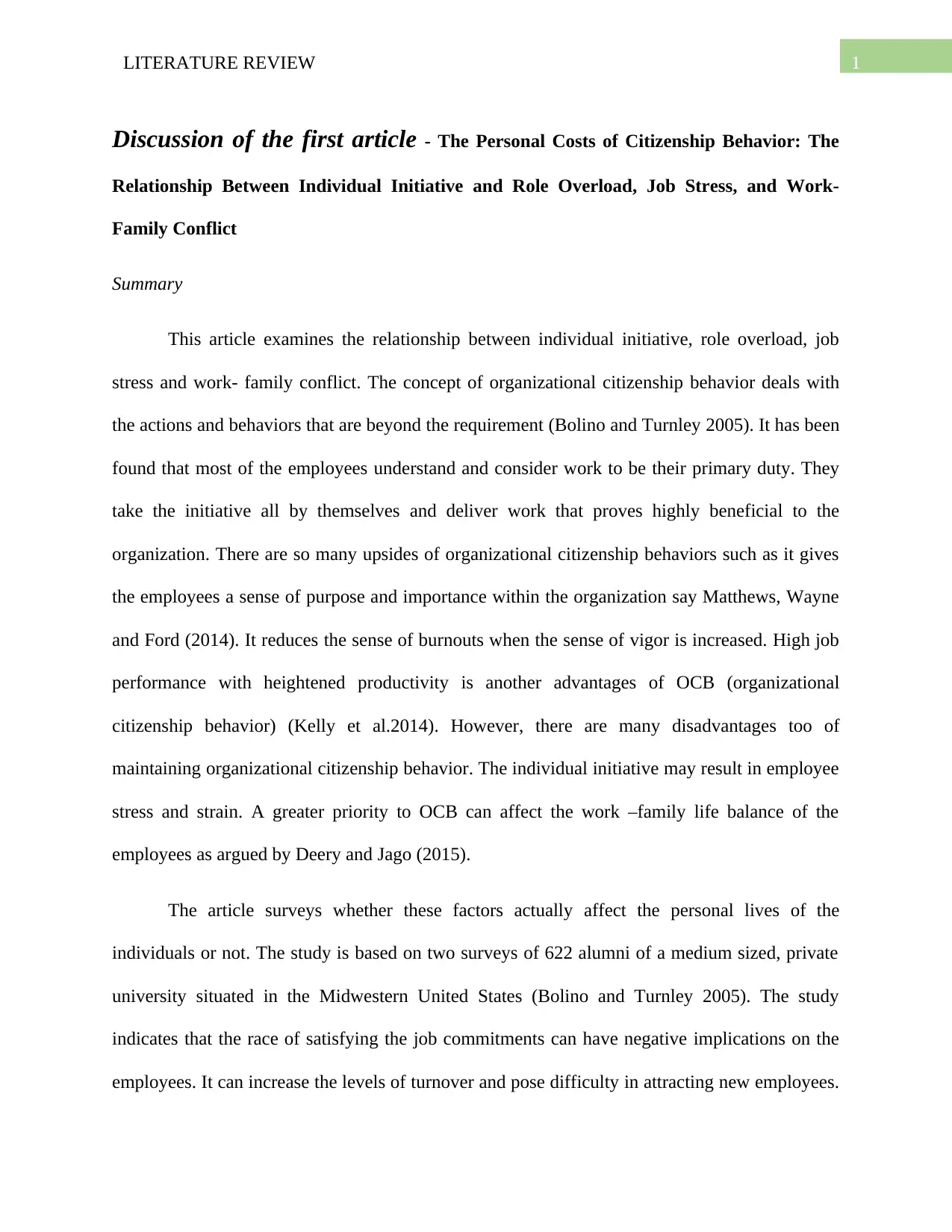
1LITERATURE REVIEW
Discussion of the first article - The Personal Costs of Citizenship Behavior: The
Relationship Between Individual Initiative and Role Overload, Job Stress, and Work-
Family Conflict
Summary
This article examines the relationship between individual initiative, role overload, job
stress and work- family conflict. The concept of organizational citizenship behavior deals with
the actions and behaviors that are beyond the requirement (Bolino and Turnley 2005). It has been
found that most of the employees understand and consider work to be their primary duty. They
take the initiative all by themselves and deliver work that proves highly beneficial to the
organization. There are so many upsides of organizational citizenship behaviors such as it gives
the employees a sense of purpose and importance within the organization say Matthews, Wayne
and Ford (2014). It reduces the sense of burnouts when the sense of vigor is increased. High job
performance with heightened productivity is another advantages of OCB (organizational
citizenship behavior) (Kelly et al.2014). However, there are many disadvantages too of
maintaining organizational citizenship behavior. The individual initiative may result in employee
stress and strain. A greater priority to OCB can affect the work –family life balance of the
employees as argued by Deery and Jago (2015).
The article surveys whether these factors actually affect the personal lives of the
individuals or not. The study is based on two surveys of 622 alumni of a medium sized, private
university situated in the Midwestern United States (Bolino and Turnley 2005). The study
indicates that the race of satisfying the job commitments can have negative implications on the
employees. It can increase the levels of turnover and pose difficulty in attracting new employees.
Discussion of the first article - The Personal Costs of Citizenship Behavior: The
Relationship Between Individual Initiative and Role Overload, Job Stress, and Work-
Family Conflict
Summary
This article examines the relationship between individual initiative, role overload, job
stress and work- family conflict. The concept of organizational citizenship behavior deals with
the actions and behaviors that are beyond the requirement (Bolino and Turnley 2005). It has been
found that most of the employees understand and consider work to be their primary duty. They
take the initiative all by themselves and deliver work that proves highly beneficial to the
organization. There are so many upsides of organizational citizenship behaviors such as it gives
the employees a sense of purpose and importance within the organization say Matthews, Wayne
and Ford (2014). It reduces the sense of burnouts when the sense of vigor is increased. High job
performance with heightened productivity is another advantages of OCB (organizational
citizenship behavior) (Kelly et al.2014). However, there are many disadvantages too of
maintaining organizational citizenship behavior. The individual initiative may result in employee
stress and strain. A greater priority to OCB can affect the work –family life balance of the
employees as argued by Deery and Jago (2015).
The article surveys whether these factors actually affect the personal lives of the
individuals or not. The study is based on two surveys of 622 alumni of a medium sized, private
university situated in the Midwestern United States (Bolino and Turnley 2005). The study
indicates that the race of satisfying the job commitments can have negative implications on the
employees. It can increase the levels of turnover and pose difficulty in attracting new employees.
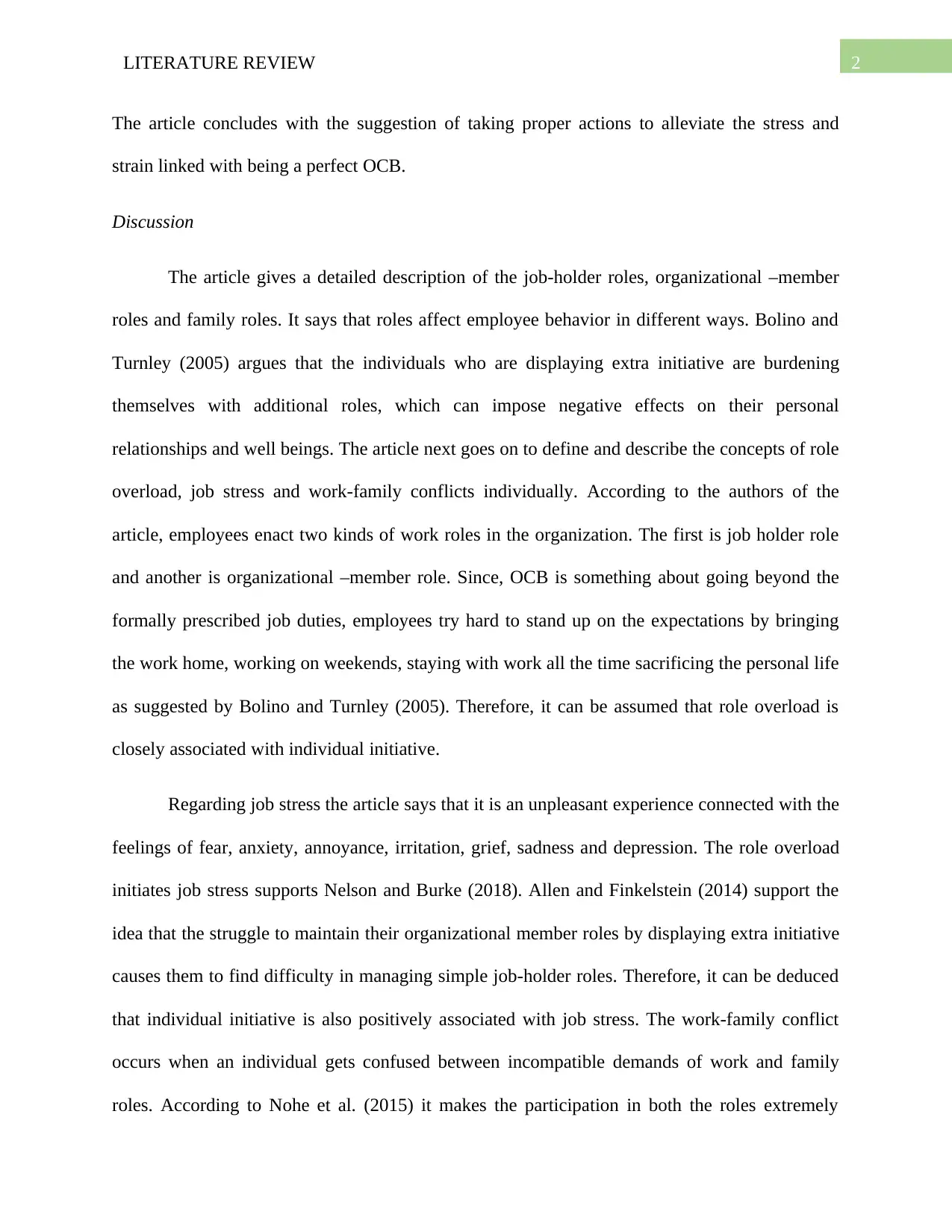
2LITERATURE REVIEW
The article concludes with the suggestion of taking proper actions to alleviate the stress and
strain linked with being a perfect OCB.
Discussion
The article gives a detailed description of the job-holder roles, organizational –member
roles and family roles. It says that roles affect employee behavior in different ways. Bolino and
Turnley (2005) argues that the individuals who are displaying extra initiative are burdening
themselves with additional roles, which can impose negative effects on their personal
relationships and well beings. The article next goes on to define and describe the concepts of role
overload, job stress and work-family conflicts individually. According to the authors of the
article, employees enact two kinds of work roles in the organization. The first is job holder role
and another is organizational –member role. Since, OCB is something about going beyond the
formally prescribed job duties, employees try hard to stand up on the expectations by bringing
the work home, working on weekends, staying with work all the time sacrificing the personal life
as suggested by Bolino and Turnley (2005). Therefore, it can be assumed that role overload is
closely associated with individual initiative.
Regarding job stress the article says that it is an unpleasant experience connected with the
feelings of fear, anxiety, annoyance, irritation, grief, sadness and depression. The role overload
initiates job stress supports Nelson and Burke (2018). Allen and Finkelstein (2014) support the
idea that the struggle to maintain their organizational member roles by displaying extra initiative
causes them to find difficulty in managing simple job-holder roles. Therefore, it can be deduced
that individual initiative is also positively associated with job stress. The work-family conflict
occurs when an individual gets confused between incompatible demands of work and family
roles. According to Nohe et al. (2015) it makes the participation in both the roles extremely
The article concludes with the suggestion of taking proper actions to alleviate the stress and
strain linked with being a perfect OCB.
Discussion
The article gives a detailed description of the job-holder roles, organizational –member
roles and family roles. It says that roles affect employee behavior in different ways. Bolino and
Turnley (2005) argues that the individuals who are displaying extra initiative are burdening
themselves with additional roles, which can impose negative effects on their personal
relationships and well beings. The article next goes on to define and describe the concepts of role
overload, job stress and work-family conflicts individually. According to the authors of the
article, employees enact two kinds of work roles in the organization. The first is job holder role
and another is organizational –member role. Since, OCB is something about going beyond the
formally prescribed job duties, employees try hard to stand up on the expectations by bringing
the work home, working on weekends, staying with work all the time sacrificing the personal life
as suggested by Bolino and Turnley (2005). Therefore, it can be assumed that role overload is
closely associated with individual initiative.
Regarding job stress the article says that it is an unpleasant experience connected with the
feelings of fear, anxiety, annoyance, irritation, grief, sadness and depression. The role overload
initiates job stress supports Nelson and Burke (2018). Allen and Finkelstein (2014) support the
idea that the struggle to maintain their organizational member roles by displaying extra initiative
causes them to find difficulty in managing simple job-holder roles. Therefore, it can be deduced
that individual initiative is also positively associated with job stress. The work-family conflict
occurs when an individual gets confused between incompatible demands of work and family
roles. According to Nohe et al. (2015) it makes the participation in both the roles extremely
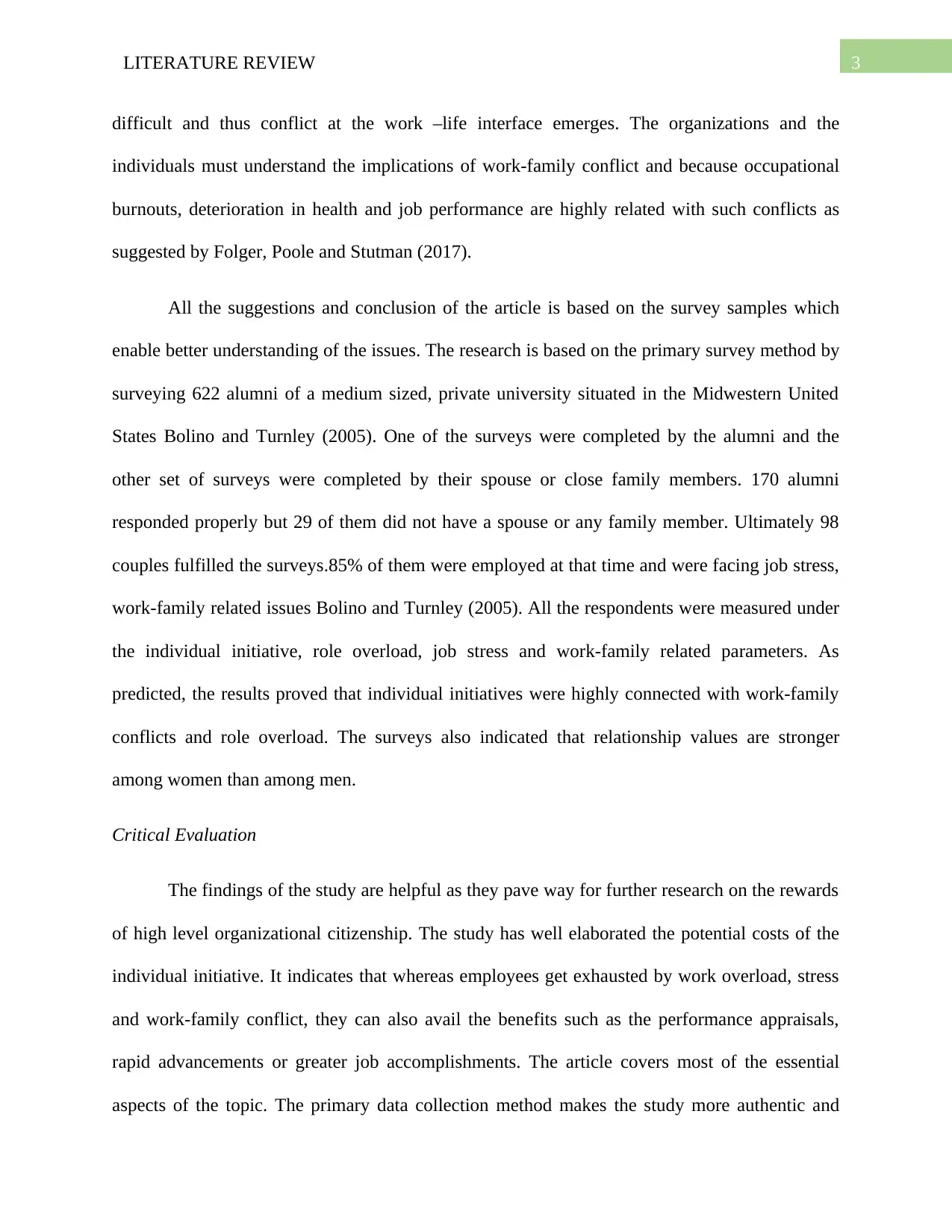
3LITERATURE REVIEW
difficult and thus conflict at the work –life interface emerges. The organizations and the
individuals must understand the implications of work-family conflict and because occupational
burnouts, deterioration in health and job performance are highly related with such conflicts as
suggested by Folger, Poole and Stutman (2017).
All the suggestions and conclusion of the article is based on the survey samples which
enable better understanding of the issues. The research is based on the primary survey method by
surveying 622 alumni of a medium sized, private university situated in the Midwestern United
States Bolino and Turnley (2005). One of the surveys were completed by the alumni and the
other set of surveys were completed by their spouse or close family members. 170 alumni
responded properly but 29 of them did not have a spouse or any family member. Ultimately 98
couples fulfilled the surveys.85% of them were employed at that time and were facing job stress,
work-family related issues Bolino and Turnley (2005). All the respondents were measured under
the individual initiative, role overload, job stress and work-family related parameters. As
predicted, the results proved that individual initiatives were highly connected with work-family
conflicts and role overload. The surveys also indicated that relationship values are stronger
among women than among men.
Critical Evaluation
The findings of the study are helpful as they pave way for further research on the rewards
of high level organizational citizenship. The study has well elaborated the potential costs of the
individual initiative. It indicates that whereas employees get exhausted by work overload, stress
and work-family conflict, they can also avail the benefits such as the performance appraisals,
rapid advancements or greater job accomplishments. The article covers most of the essential
aspects of the topic. The primary data collection method makes the study more authentic and
difficult and thus conflict at the work –life interface emerges. The organizations and the
individuals must understand the implications of work-family conflict and because occupational
burnouts, deterioration in health and job performance are highly related with such conflicts as
suggested by Folger, Poole and Stutman (2017).
All the suggestions and conclusion of the article is based on the survey samples which
enable better understanding of the issues. The research is based on the primary survey method by
surveying 622 alumni of a medium sized, private university situated in the Midwestern United
States Bolino and Turnley (2005). One of the surveys were completed by the alumni and the
other set of surveys were completed by their spouse or close family members. 170 alumni
responded properly but 29 of them did not have a spouse or any family member. Ultimately 98
couples fulfilled the surveys.85% of them were employed at that time and were facing job stress,
work-family related issues Bolino and Turnley (2005). All the respondents were measured under
the individual initiative, role overload, job stress and work-family related parameters. As
predicted, the results proved that individual initiatives were highly connected with work-family
conflicts and role overload. The surveys also indicated that relationship values are stronger
among women than among men.
Critical Evaluation
The findings of the study are helpful as they pave way for further research on the rewards
of high level organizational citizenship. The study has well elaborated the potential costs of the
individual initiative. It indicates that whereas employees get exhausted by work overload, stress
and work-family conflict, they can also avail the benefits such as the performance appraisals,
rapid advancements or greater job accomplishments. The article covers most of the essential
aspects of the topic. The primary data collection method makes the study more authentic and
Secure Best Marks with AI Grader
Need help grading? Try our AI Grader for instant feedback on your assignments.
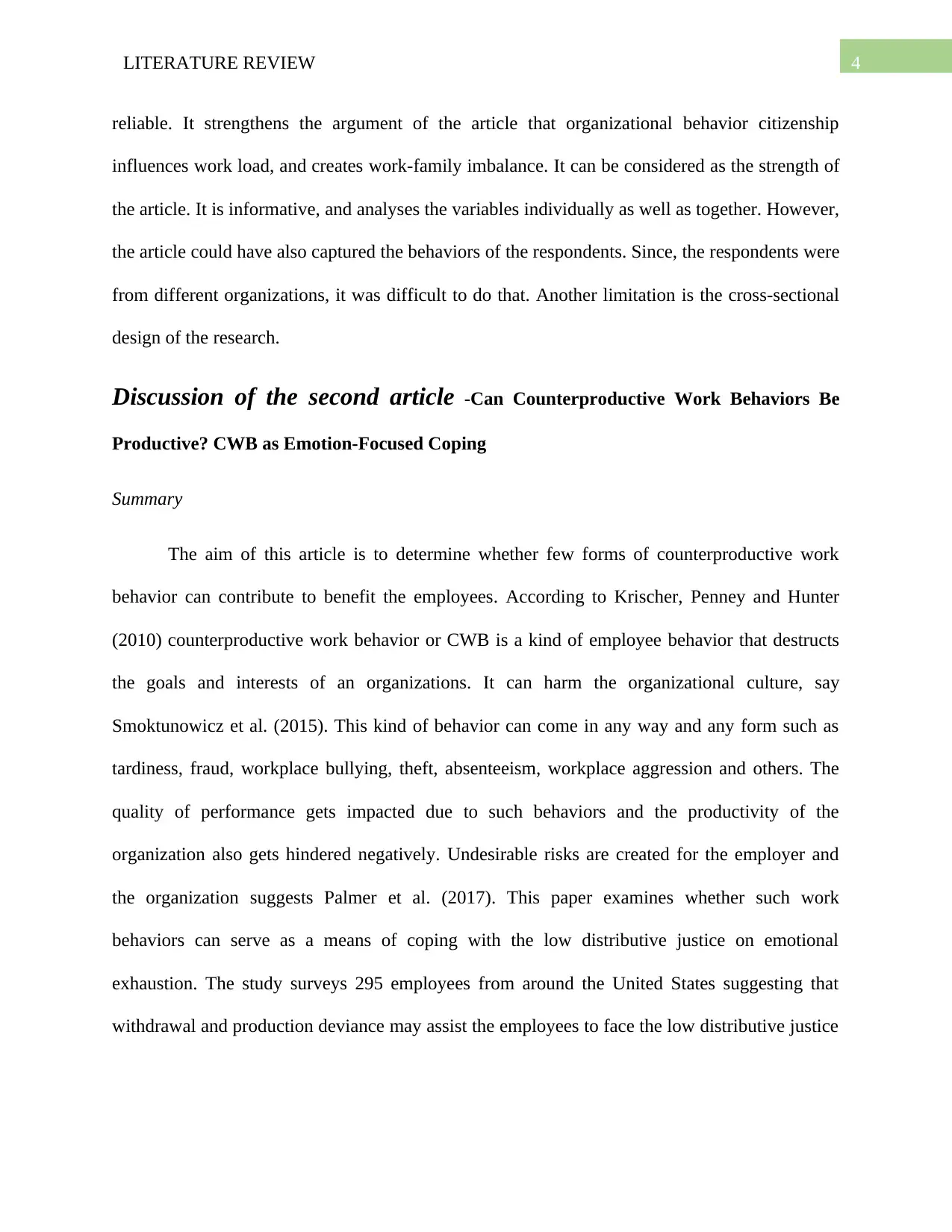
4LITERATURE REVIEW
reliable. It strengthens the argument of the article that organizational behavior citizenship
influences work load, and creates work-family imbalance. It can be considered as the strength of
the article. It is informative, and analyses the variables individually as well as together. However,
the article could have also captured the behaviors of the respondents. Since, the respondents were
from different organizations, it was difficult to do that. Another limitation is the cross-sectional
design of the research.
Discussion of the second article -Can Counterproductive Work Behaviors Be
Productive? CWB as Emotion-Focused Coping
Summary
The aim of this article is to determine whether few forms of counterproductive work
behavior can contribute to benefit the employees. According to Krischer, Penney and Hunter
(2010) counterproductive work behavior or CWB is a kind of employee behavior that destructs
the goals and interests of an organizations. It can harm the organizational culture, say
Smoktunowicz et al. (2015). This kind of behavior can come in any way and any form such as
tardiness, fraud, workplace bullying, theft, absenteeism, workplace aggression and others. The
quality of performance gets impacted due to such behaviors and the productivity of the
organization also gets hindered negatively. Undesirable risks are created for the employer and
the organization suggests Palmer et al. (2017). This paper examines whether such work
behaviors can serve as a means of coping with the low distributive justice on emotional
exhaustion. The study surveys 295 employees from around the United States suggesting that
withdrawal and production deviance may assist the employees to face the low distributive justice
reliable. It strengthens the argument of the article that organizational behavior citizenship
influences work load, and creates work-family imbalance. It can be considered as the strength of
the article. It is informative, and analyses the variables individually as well as together. However,
the article could have also captured the behaviors of the respondents. Since, the respondents were
from different organizations, it was difficult to do that. Another limitation is the cross-sectional
design of the research.
Discussion of the second article -Can Counterproductive Work Behaviors Be
Productive? CWB as Emotion-Focused Coping
Summary
The aim of this article is to determine whether few forms of counterproductive work
behavior can contribute to benefit the employees. According to Krischer, Penney and Hunter
(2010) counterproductive work behavior or CWB is a kind of employee behavior that destructs
the goals and interests of an organizations. It can harm the organizational culture, say
Smoktunowicz et al. (2015). This kind of behavior can come in any way and any form such as
tardiness, fraud, workplace bullying, theft, absenteeism, workplace aggression and others. The
quality of performance gets impacted due to such behaviors and the productivity of the
organization also gets hindered negatively. Undesirable risks are created for the employer and
the organization suggests Palmer et al. (2017). This paper examines whether such work
behaviors can serve as a means of coping with the low distributive justice on emotional
exhaustion. The study surveys 295 employees from around the United States suggesting that
withdrawal and production deviance may assist the employees to face the low distributive justice

5LITERATURE REVIEW
and reduces emotional exhaustion (Krischer, Penney and Hunter 2010). The entire study is based
on the stressor-strain framework and coping theories.
The article further says that every year CWB incurs billions of organizational costs each
year as informed by Krischer, Penney and Hunter (2010). The theories of emotion regulations
and coping can give an alternative perspective on the deliberate performance of such activities.
The article provides a detailed description of the emotional exhaustion and the stressor-strain
framework relation between coping and CWB, organizational justice as one of the most
commonly researched organizational stressors. The study finally concludes by giving an
overview of the findings saying that withdrawal and production deviance work are instrumental
in reducing employee emotional exhaustion when they are extremely stressed by the organization
they work in. Emotional exhaustion give rise to low employee motivation, performance and job
performance. The organization ultimately gets benefitted by such behaviors because if the
employee is not emotionally and physically strong, then he/she cannot perform up to the mark.
Therefore, such outbursts are healthy for the employee as well as for the organization as a whole.
Discussion
First of the all the article is descriptive of the relation between emotional exhaustion and
stressor –strain framework (Krischer, Penney and Hunter 2010). Emotional exhaustion is
considered to be a significant emotional strain. The rates of burnouts usually get increased by
emotional exhaustion. According to Marcus et al. (2016) the emotional resources get hampered
by emotional exhaustion which gives rise to employee turnover. It also affects the personal
accomplishments. The stressor –strain frame work helps to measure how a variety of negative
events can lead to emotional exhaustion, the subsequent counterproductive work behaviors and
coping. In the workplace role conflict, role ambiguity, role overload, organizational constraints
and reduces emotional exhaustion (Krischer, Penney and Hunter 2010). The entire study is based
on the stressor-strain framework and coping theories.
The article further says that every year CWB incurs billions of organizational costs each
year as informed by Krischer, Penney and Hunter (2010). The theories of emotion regulations
and coping can give an alternative perspective on the deliberate performance of such activities.
The article provides a detailed description of the emotional exhaustion and the stressor-strain
framework relation between coping and CWB, organizational justice as one of the most
commonly researched organizational stressors. The study finally concludes by giving an
overview of the findings saying that withdrawal and production deviance work are instrumental
in reducing employee emotional exhaustion when they are extremely stressed by the organization
they work in. Emotional exhaustion give rise to low employee motivation, performance and job
performance. The organization ultimately gets benefitted by such behaviors because if the
employee is not emotionally and physically strong, then he/she cannot perform up to the mark.
Therefore, such outbursts are healthy for the employee as well as for the organization as a whole.
Discussion
First of the all the article is descriptive of the relation between emotional exhaustion and
stressor –strain framework (Krischer, Penney and Hunter 2010). Emotional exhaustion is
considered to be a significant emotional strain. The rates of burnouts usually get increased by
emotional exhaustion. According to Marcus et al. (2016) the emotional resources get hampered
by emotional exhaustion which gives rise to employee turnover. It also affects the personal
accomplishments. The stressor –strain frame work helps to measure how a variety of negative
events can lead to emotional exhaustion, the subsequent counterproductive work behaviors and
coping. In the workplace role conflict, role ambiguity, role overload, organizational constraints
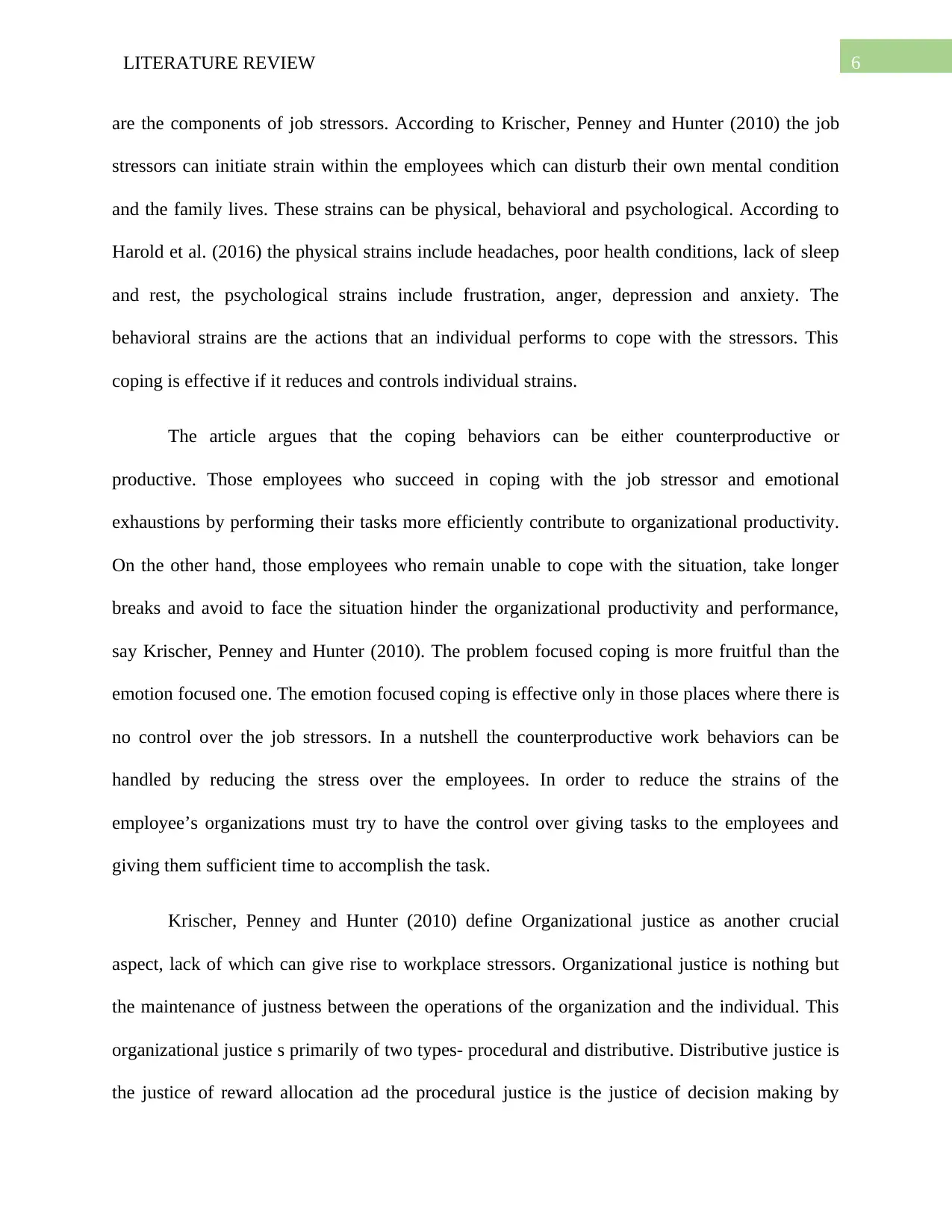
6LITERATURE REVIEW
are the components of job stressors. According to Krischer, Penney and Hunter (2010) the job
stressors can initiate strain within the employees which can disturb their own mental condition
and the family lives. These strains can be physical, behavioral and psychological. According to
Harold et al. (2016) the physical strains include headaches, poor health conditions, lack of sleep
and rest, the psychological strains include frustration, anger, depression and anxiety. The
behavioral strains are the actions that an individual performs to cope with the stressors. This
coping is effective if it reduces and controls individual strains.
The article argues that the coping behaviors can be either counterproductive or
productive. Those employees who succeed in coping with the job stressor and emotional
exhaustions by performing their tasks more efficiently contribute to organizational productivity.
On the other hand, those employees who remain unable to cope with the situation, take longer
breaks and avoid to face the situation hinder the organizational productivity and performance,
say Krischer, Penney and Hunter (2010). The problem focused coping is more fruitful than the
emotion focused one. The emotion focused coping is effective only in those places where there is
no control over the job stressors. In a nutshell the counterproductive work behaviors can be
handled by reducing the stress over the employees. In order to reduce the strains of the
employee’s organizations must try to have the control over giving tasks to the employees and
giving them sufficient time to accomplish the task.
Krischer, Penney and Hunter (2010) define Organizational justice as another crucial
aspect, lack of which can give rise to workplace stressors. Organizational justice is nothing but
the maintenance of justness between the operations of the organization and the individual. This
organizational justice s primarily of two types- procedural and distributive. Distributive justice is
the justice of reward allocation ad the procedural justice is the justice of decision making by
are the components of job stressors. According to Krischer, Penney and Hunter (2010) the job
stressors can initiate strain within the employees which can disturb their own mental condition
and the family lives. These strains can be physical, behavioral and psychological. According to
Harold et al. (2016) the physical strains include headaches, poor health conditions, lack of sleep
and rest, the psychological strains include frustration, anger, depression and anxiety. The
behavioral strains are the actions that an individual performs to cope with the stressors. This
coping is effective if it reduces and controls individual strains.
The article argues that the coping behaviors can be either counterproductive or
productive. Those employees who succeed in coping with the job stressor and emotional
exhaustions by performing their tasks more efficiently contribute to organizational productivity.
On the other hand, those employees who remain unable to cope with the situation, take longer
breaks and avoid to face the situation hinder the organizational productivity and performance,
say Krischer, Penney and Hunter (2010). The problem focused coping is more fruitful than the
emotion focused one. The emotion focused coping is effective only in those places where there is
no control over the job stressors. In a nutshell the counterproductive work behaviors can be
handled by reducing the stress over the employees. In order to reduce the strains of the
employee’s organizations must try to have the control over giving tasks to the employees and
giving them sufficient time to accomplish the task.
Krischer, Penney and Hunter (2010) define Organizational justice as another crucial
aspect, lack of which can give rise to workplace stressors. Organizational justice is nothing but
the maintenance of justness between the operations of the organization and the individual. This
organizational justice s primarily of two types- procedural and distributive. Distributive justice is
the justice of reward allocation ad the procedural justice is the justice of decision making by
Paraphrase This Document
Need a fresh take? Get an instant paraphrase of this document with our AI Paraphraser
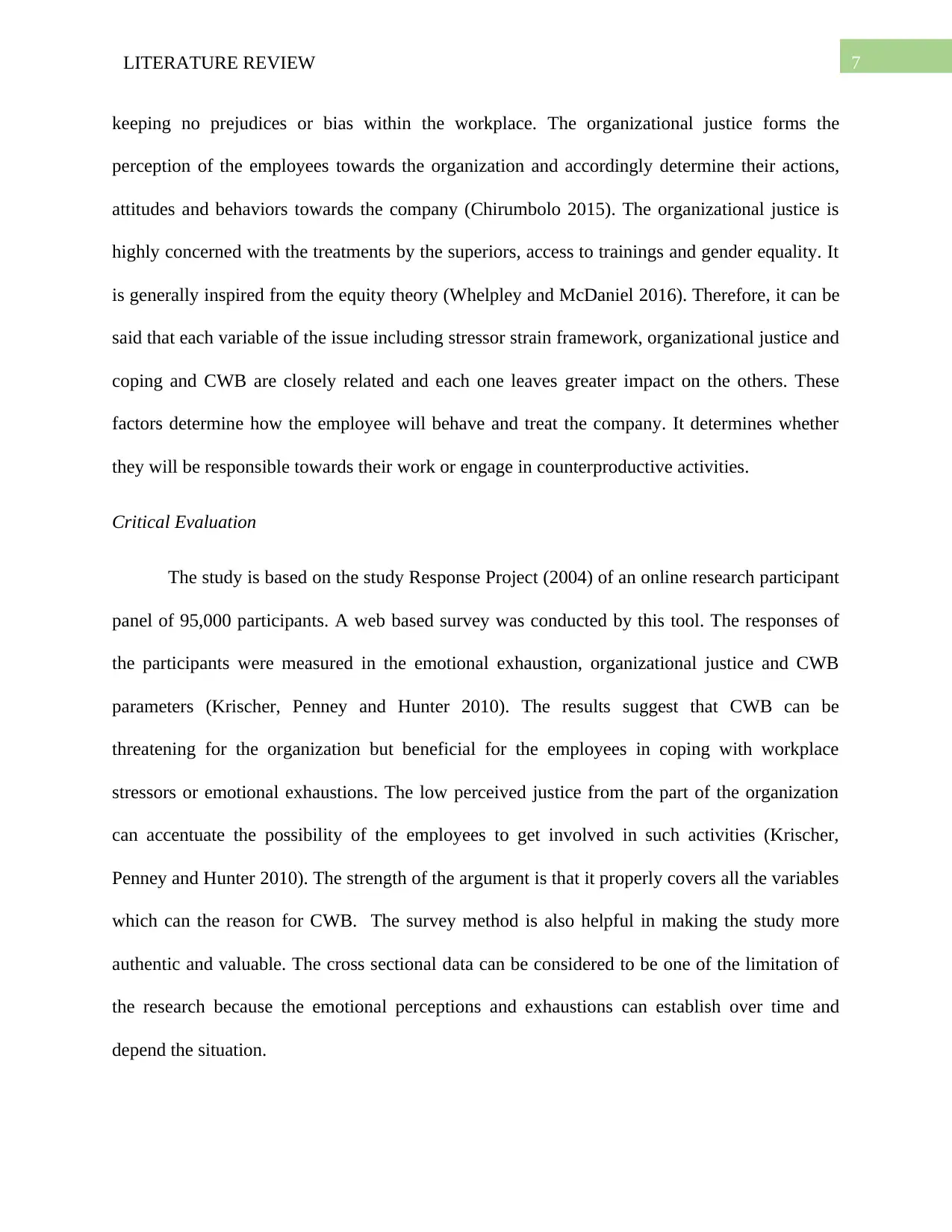
7LITERATURE REVIEW
keeping no prejudices or bias within the workplace. The organizational justice forms the
perception of the employees towards the organization and accordingly determine their actions,
attitudes and behaviors towards the company (Chirumbolo 2015). The organizational justice is
highly concerned with the treatments by the superiors, access to trainings and gender equality. It
is generally inspired from the equity theory (Whelpley and McDaniel 2016). Therefore, it can be
said that each variable of the issue including stressor strain framework, organizational justice and
coping and CWB are closely related and each one leaves greater impact on the others. These
factors determine how the employee will behave and treat the company. It determines whether
they will be responsible towards their work or engage in counterproductive activities.
Critical Evaluation
The study is based on the study Response Project (2004) of an online research participant
panel of 95,000 participants. A web based survey was conducted by this tool. The responses of
the participants were measured in the emotional exhaustion, organizational justice and CWB
parameters (Krischer, Penney and Hunter 2010). The results suggest that CWB can be
threatening for the organization but beneficial for the employees in coping with workplace
stressors or emotional exhaustions. The low perceived justice from the part of the organization
can accentuate the possibility of the employees to get involved in such activities (Krischer,
Penney and Hunter 2010). The strength of the argument is that it properly covers all the variables
which can the reason for CWB. The survey method is also helpful in making the study more
authentic and valuable. The cross sectional data can be considered to be one of the limitation of
the research because the emotional perceptions and exhaustions can establish over time and
depend the situation.
keeping no prejudices or bias within the workplace. The organizational justice forms the
perception of the employees towards the organization and accordingly determine their actions,
attitudes and behaviors towards the company (Chirumbolo 2015). The organizational justice is
highly concerned with the treatments by the superiors, access to trainings and gender equality. It
is generally inspired from the equity theory (Whelpley and McDaniel 2016). Therefore, it can be
said that each variable of the issue including stressor strain framework, organizational justice and
coping and CWB are closely related and each one leaves greater impact on the others. These
factors determine how the employee will behave and treat the company. It determines whether
they will be responsible towards their work or engage in counterproductive activities.
Critical Evaluation
The study is based on the study Response Project (2004) of an online research participant
panel of 95,000 participants. A web based survey was conducted by this tool. The responses of
the participants were measured in the emotional exhaustion, organizational justice and CWB
parameters (Krischer, Penney and Hunter 2010). The results suggest that CWB can be
threatening for the organization but beneficial for the employees in coping with workplace
stressors or emotional exhaustions. The low perceived justice from the part of the organization
can accentuate the possibility of the employees to get involved in such activities (Krischer,
Penney and Hunter 2010). The strength of the argument is that it properly covers all the variables
which can the reason for CWB. The survey method is also helpful in making the study more
authentic and valuable. The cross sectional data can be considered to be one of the limitation of
the research because the emotional perceptions and exhaustions can establish over time and
depend the situation.

8LITERATURE REVIEW
Comparison
The first article which studies the personal costs of citizenship behaviors, the relationship
between individual initiative and work overload, job stress and work family conflict is extremely
helpful because it genuinely covers all the important aspects of the topic and assists in better
understanding the main issues. I have understood that in order to maintain the citizenship
behaviors employees try to work beyond the requirement and in the meantime hamper their
personal and family lives. The methodology is helpful as they are based on the primary data
collection which provides proof and supports the argument of the article. On the other hand, the
second article which deals with the counterproductive work behaviors also highlights the same
topics though in a different way.
I have found that job stress, work overload, emotional exhaustion, work- family
imbalance and incompatibility are the similar topics that both the articles hover around.
However, the methodology that they have used area different in their own way. The second
article uses the web designed data collection method which is unique in its own way. As a whole
both the articles are highly informative and the language the authors have used are simple and
lucid. This enables to understand the topics in a better way. The first article throws more light on
the work-life related issues while the second article emphasizes the need for organizational
justice in handling the job stressors within an organization and maintain the well-being of the
employees. Both the articles have their own limitations but cross –sectional data collection has
been considered to be the similar limitations.
Comparison
The first article which studies the personal costs of citizenship behaviors, the relationship
between individual initiative and work overload, job stress and work family conflict is extremely
helpful because it genuinely covers all the important aspects of the topic and assists in better
understanding the main issues. I have understood that in order to maintain the citizenship
behaviors employees try to work beyond the requirement and in the meantime hamper their
personal and family lives. The methodology is helpful as they are based on the primary data
collection which provides proof and supports the argument of the article. On the other hand, the
second article which deals with the counterproductive work behaviors also highlights the same
topics though in a different way.
I have found that job stress, work overload, emotional exhaustion, work- family
imbalance and incompatibility are the similar topics that both the articles hover around.
However, the methodology that they have used area different in their own way. The second
article uses the web designed data collection method which is unique in its own way. As a whole
both the articles are highly informative and the language the authors have used are simple and
lucid. This enables to understand the topics in a better way. The first article throws more light on
the work-life related issues while the second article emphasizes the need for organizational
justice in handling the job stressors within an organization and maintain the well-being of the
employees. Both the articles have their own limitations but cross –sectional data collection has
been considered to be the similar limitations.
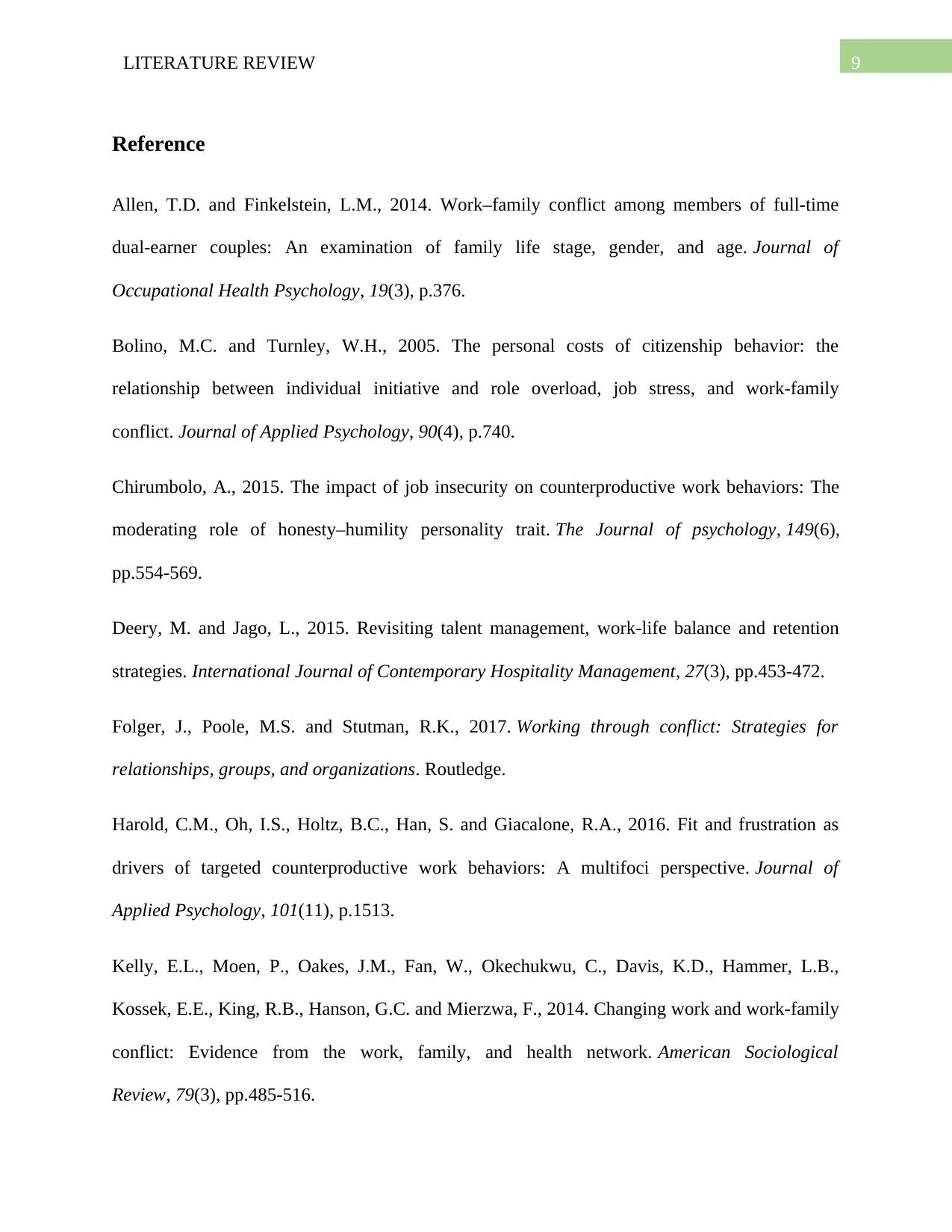
9LITERATURE REVIEW
Reference
Allen, T.D. and Finkelstein, L.M., 2014. Work–family conflict among members of full-time
dual-earner couples: An examination of family life stage, gender, and age. Journal of
Occupational Health Psychology, 19(3), p.376.
Bolino, M.C. and Turnley, W.H., 2005. The personal costs of citizenship behavior: the
relationship between individual initiative and role overload, job stress, and work-family
conflict. Journal of Applied Psychology, 90(4), p.740.
Chirumbolo, A., 2015. The impact of job insecurity on counterproductive work behaviors: The
moderating role of honesty–humility personality trait. The Journal of psychology, 149(6),
pp.554-569.
Deery, M. and Jago, L., 2015. Revisiting talent management, work-life balance and retention
strategies. International Journal of Contemporary Hospitality Management, 27(3), pp.453-472.
Folger, J., Poole, M.S. and Stutman, R.K., 2017. Working through conflict: Strategies for
relationships, groups, and organizations. Routledge.
Harold, C.M., Oh, I.S., Holtz, B.C., Han, S. and Giacalone, R.A., 2016. Fit and frustration as
drivers of targeted counterproductive work behaviors: A multifoci perspective. Journal of
Applied Psychology, 101(11), p.1513.
Kelly, E.L., Moen, P., Oakes, J.M., Fan, W., Okechukwu, C., Davis, K.D., Hammer, L.B.,
Kossek, E.E., King, R.B., Hanson, G.C. and Mierzwa, F., 2014. Changing work and work-family
conflict: Evidence from the work, family, and health network. American Sociological
Review, 79(3), pp.485-516.
Reference
Allen, T.D. and Finkelstein, L.M., 2014. Work–family conflict among members of full-time
dual-earner couples: An examination of family life stage, gender, and age. Journal of
Occupational Health Psychology, 19(3), p.376.
Bolino, M.C. and Turnley, W.H., 2005. The personal costs of citizenship behavior: the
relationship between individual initiative and role overload, job stress, and work-family
conflict. Journal of Applied Psychology, 90(4), p.740.
Chirumbolo, A., 2015. The impact of job insecurity on counterproductive work behaviors: The
moderating role of honesty–humility personality trait. The Journal of psychology, 149(6),
pp.554-569.
Deery, M. and Jago, L., 2015. Revisiting talent management, work-life balance and retention
strategies. International Journal of Contemporary Hospitality Management, 27(3), pp.453-472.
Folger, J., Poole, M.S. and Stutman, R.K., 2017. Working through conflict: Strategies for
relationships, groups, and organizations. Routledge.
Harold, C.M., Oh, I.S., Holtz, B.C., Han, S. and Giacalone, R.A., 2016. Fit and frustration as
drivers of targeted counterproductive work behaviors: A multifoci perspective. Journal of
Applied Psychology, 101(11), p.1513.
Kelly, E.L., Moen, P., Oakes, J.M., Fan, W., Okechukwu, C., Davis, K.D., Hammer, L.B.,
Kossek, E.E., King, R.B., Hanson, G.C. and Mierzwa, F., 2014. Changing work and work-family
conflict: Evidence from the work, family, and health network. American Sociological
Review, 79(3), pp.485-516.
Secure Best Marks with AI Grader
Need help grading? Try our AI Grader for instant feedback on your assignments.
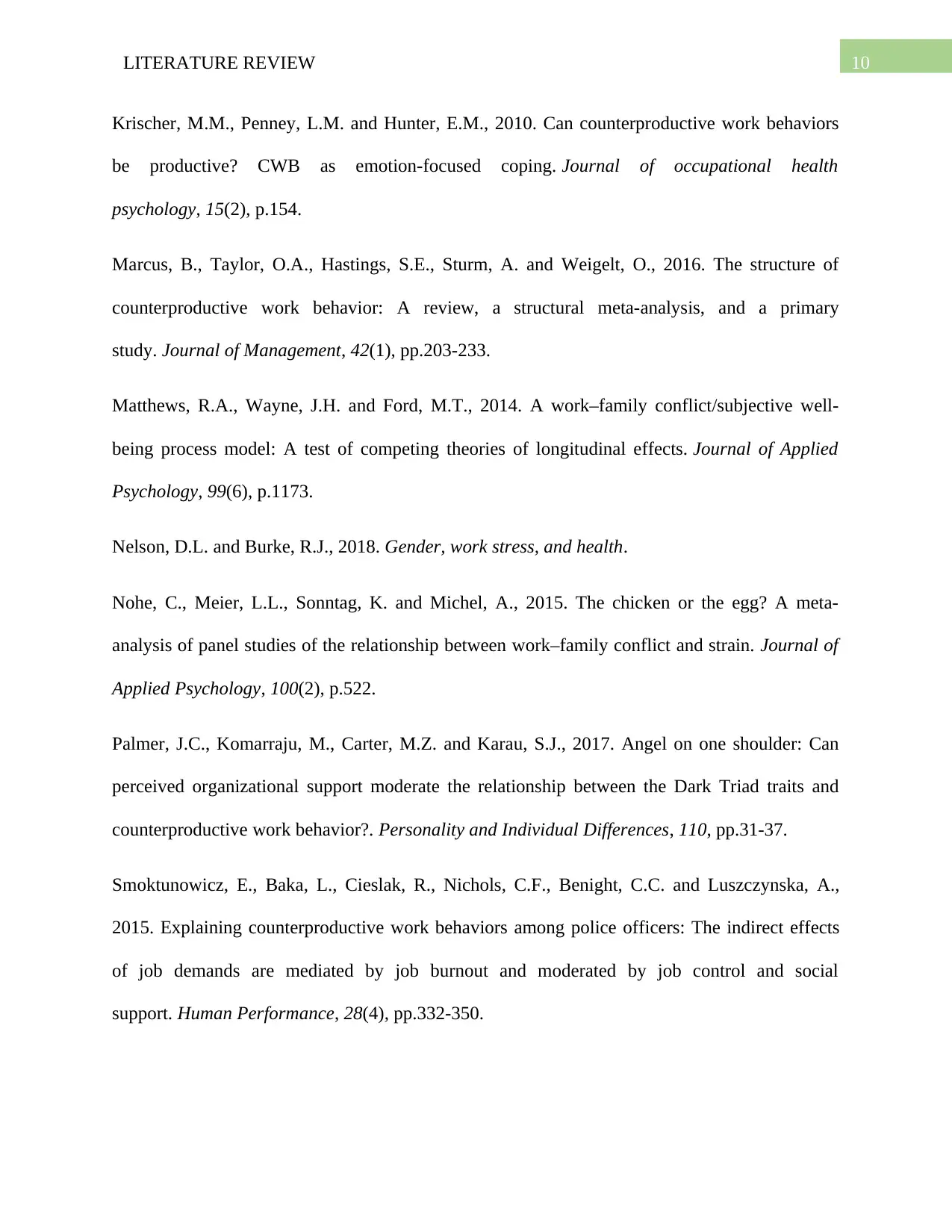
10LITERATURE REVIEW
Krischer, M.M., Penney, L.M. and Hunter, E.M., 2010. Can counterproductive work behaviors
be productive? CWB as emotion-focused coping. Journal of occupational health
psychology, 15(2), p.154.
Marcus, B., Taylor, O.A., Hastings, S.E., Sturm, A. and Weigelt, O., 2016. The structure of
counterproductive work behavior: A review, a structural meta-analysis, and a primary
study. Journal of Management, 42(1), pp.203-233.
Matthews, R.A., Wayne, J.H. and Ford, M.T., 2014. A work–family conflict/subjective well-
being process model: A test of competing theories of longitudinal effects. Journal of Applied
Psychology, 99(6), p.1173.
Nelson, D.L. and Burke, R.J., 2018. Gender, work stress, and health.
Nohe, C., Meier, L.L., Sonntag, K. and Michel, A., 2015. The chicken or the egg? A meta-
analysis of panel studies of the relationship between work–family conflict and strain. Journal of
Applied Psychology, 100(2), p.522.
Palmer, J.C., Komarraju, M., Carter, M.Z. and Karau, S.J., 2017. Angel on one shoulder: Can
perceived organizational support moderate the relationship between the Dark Triad traits and
counterproductive work behavior?. Personality and Individual Differences, 110, pp.31-37.
Smoktunowicz, E., Baka, L., Cieslak, R., Nichols, C.F., Benight, C.C. and Luszczynska, A.,
2015. Explaining counterproductive work behaviors among police officers: The indirect effects
of job demands are mediated by job burnout and moderated by job control and social
support. Human Performance, 28(4), pp.332-350.
Krischer, M.M., Penney, L.M. and Hunter, E.M., 2010. Can counterproductive work behaviors
be productive? CWB as emotion-focused coping. Journal of occupational health
psychology, 15(2), p.154.
Marcus, B., Taylor, O.A., Hastings, S.E., Sturm, A. and Weigelt, O., 2016. The structure of
counterproductive work behavior: A review, a structural meta-analysis, and a primary
study. Journal of Management, 42(1), pp.203-233.
Matthews, R.A., Wayne, J.H. and Ford, M.T., 2014. A work–family conflict/subjective well-
being process model: A test of competing theories of longitudinal effects. Journal of Applied
Psychology, 99(6), p.1173.
Nelson, D.L. and Burke, R.J., 2018. Gender, work stress, and health.
Nohe, C., Meier, L.L., Sonntag, K. and Michel, A., 2015. The chicken or the egg? A meta-
analysis of panel studies of the relationship between work–family conflict and strain. Journal of
Applied Psychology, 100(2), p.522.
Palmer, J.C., Komarraju, M., Carter, M.Z. and Karau, S.J., 2017. Angel on one shoulder: Can
perceived organizational support moderate the relationship between the Dark Triad traits and
counterproductive work behavior?. Personality and Individual Differences, 110, pp.31-37.
Smoktunowicz, E., Baka, L., Cieslak, R., Nichols, C.F., Benight, C.C. and Luszczynska, A.,
2015. Explaining counterproductive work behaviors among police officers: The indirect effects
of job demands are mediated by job burnout and moderated by job control and social
support. Human Performance, 28(4), pp.332-350.
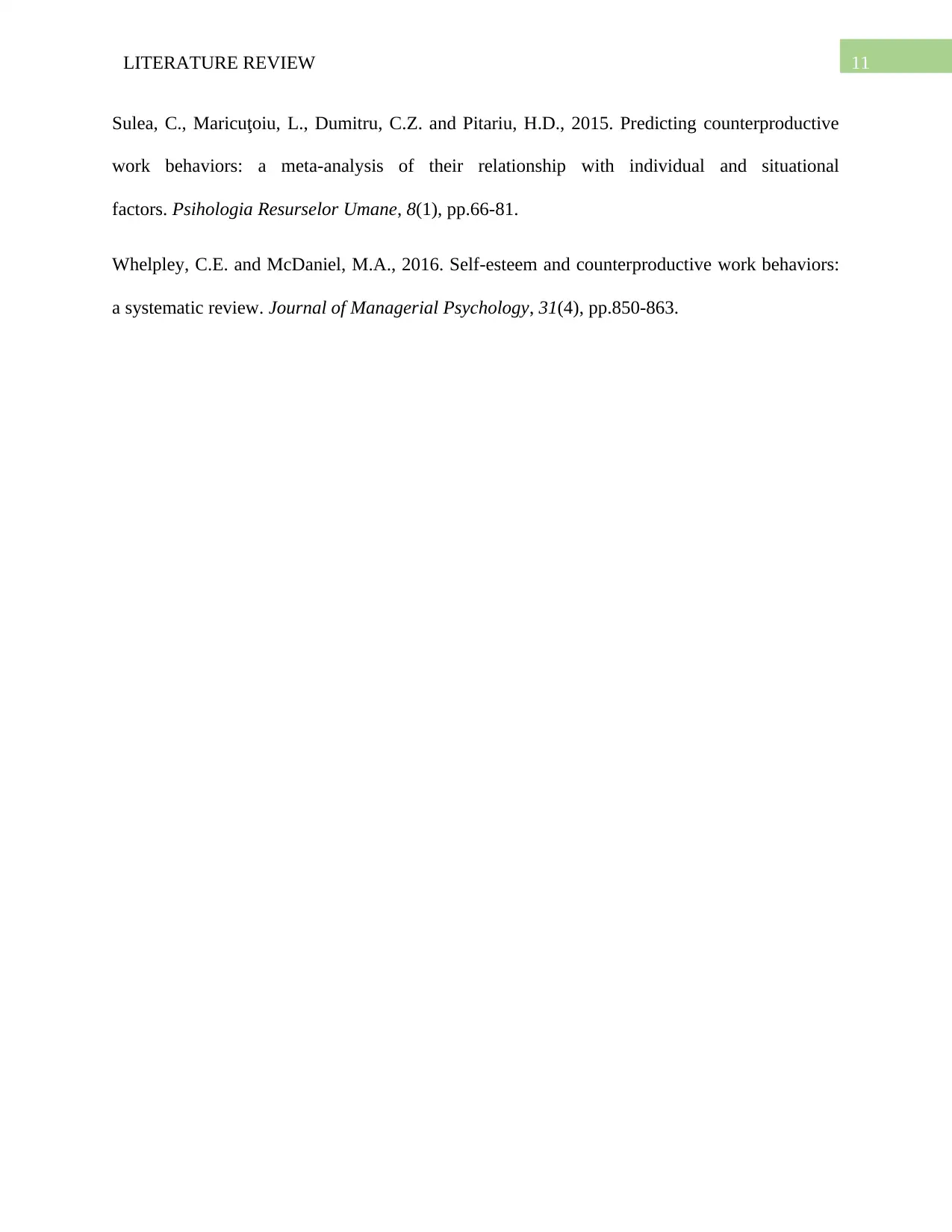
11LITERATURE REVIEW
Sulea, C., Maricuţoiu, L., Dumitru, C.Z. and Pitariu, H.D., 2015. Predicting counterproductive
work behaviors: a meta-analysis of their relationship with individual and situational
factors. Psihologia Resurselor Umane, 8(1), pp.66-81.
Whelpley, C.E. and McDaniel, M.A., 2016. Self-esteem and counterproductive work behaviors:
a systematic review. Journal of Managerial Psychology, 31(4), pp.850-863.
Sulea, C., Maricuţoiu, L., Dumitru, C.Z. and Pitariu, H.D., 2015. Predicting counterproductive
work behaviors: a meta-analysis of their relationship with individual and situational
factors. Psihologia Resurselor Umane, 8(1), pp.66-81.
Whelpley, C.E. and McDaniel, M.A., 2016. Self-esteem and counterproductive work behaviors:
a systematic review. Journal of Managerial Psychology, 31(4), pp.850-863.
1 out of 12
Your All-in-One AI-Powered Toolkit for Academic Success.
+13062052269
info@desklib.com
Available 24*7 on WhatsApp / Email
![[object Object]](/_next/static/media/star-bottom.7253800d.svg)
Unlock your academic potential
© 2024 | Zucol Services PVT LTD | All rights reserved.

